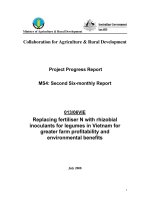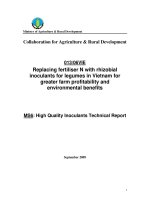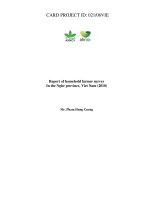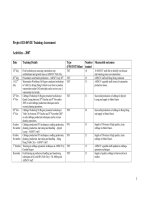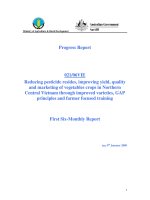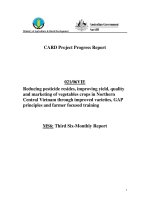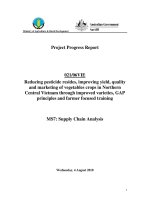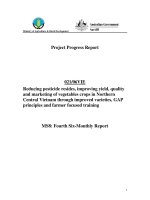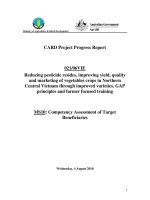Báo cáo khoa học nông nghiệp " Shrimp GAP and BMP in Vietnam: Policy, current status and future direction " pdf
Bạn đang xem bản rút gọn của tài liệu. Xem và tải ngay bản đầy đủ của tài liệu tại đây (321.42 KB, 21 trang )
1
Shrimp GAP and BMP in Vietnam:
Policy, current status and future direction
Abstract:
This paper summarizes the resources (natural, climatic, environmental and physical) available for
shrimp culture in Vietnam and details the different shrimp production systems currently practiced for
grow-out in Vietnam. Data are given on the rapid increase in Vietnamese shrimp production over the
last decade and the progress and current status of implementing Good Aquaculture Practices (GAP)
and Better Management Practices (BMP) in Vietnam is also compared and contrasted with other
countries in the Asian region. Issues and constraints to the implementation of GAP and BMP in
Vietnam are discussed. Specific recommendations are given for future direction to facilitate GAP and
BMP in Vietnam and specific activities to be initiated by government institutions, donor funded
initiatives and the private sector to promote shrimp GAP and BMP implementation in Vietnam.
Authors:
Dr. Vu Dzung Tien
1
and Mr. Don Griffiths
2
.
Contents
1. The importance of the fishery sector: 1
2. Shrimp production systems in Vietnam 4
3. Development of shrimp GAP and BMP in Vietnam 6
4. Current status of GAP, BMP and COC implementation 11
5. Future Direction for GAP, BMP and COC implementation 12
6. References 13
Tables 1-7 14-21
1.Theimportanceofthefisherysector:
The fishery sector of Vietnam contributes significantly to rural household food security, nutrition,
livelihoods, income generation and employment.
Food consumption surveys estimate that aquatic products provide 50% of the dietary protein intake of
the Vietnamese people. Per capita consumption of aquatic products has increased from 13.2 kg in
1990 to 18.7 kg in 2000 and 19.4 kg in 2002. However there are large geographical differences in
estimated fish consumption in Vietnam from as low as 12 kg capita
-1
year
-1
in the north, an average of
1
Deputy National Component Director, Sustainable Development of Aquaculture, Fisheries Sector Programme Support,
Phase II. Contact at
and
2
Senior Advisor (Brackishwater and Marine Aquaculture), SUDA, FSPS II. Contact at
2
30 kg capita
-1
year
-1
in the Mekong Delta region in the south, up to as high as 60 kg capita
-1
year
-1
in
Long An province, according to a Mekong River Commission survey.
Approximately four million people are employed full time in the Vietnamese fisheries sector, while
an estimated 8.5 million people (10% of the total population) derive their main proportion of their
income either directly or indirectly from the fishery sector. In addition at least 10 million Vietnamese
capture aquatic products at least seasonally from marine, and inland fisheries, and rice fields.
The fishery sector is a significant and fast growing component of the Vietnamese economy. The
fishery sector contributes approximately 4% of GDP, 8% of export value and 10% of total
employment.
From 2005 to 2008 Vietnam’s aquatic production volume increased from 3,465,900 to 4,574,9003
tonnes (See Table 1 below). The Mekong Delta region provinces alone, contributed 50% of the total
aquatic production. In 2007 Vietnamese aquaculture production at 2,085,200 tonnes was greater for
the first time, than marine capture fisheries at 2,063,800 tonnes. The fishery sector is the fourth most
important export sector, after oil, garments and footwear. Fishery sector exports have expanded at an
average growth rate of 18% annually for the last decade. In 2008 the fishery sector of Vietnam
exported 1,236,289 tonnes of aquatic products with a value of US$ 4.509 billion. This was a 51%
increase in volume and a 61% increase in value from 2005 when 626,991 tonnes of aquatic products,
worth USD 2.738 billion were exported
3
.
From 2005 to 2007 the total area of land in Vietnam used for aquaculture area increased 5.8% from
952,600 to 1,008,000 hectares. Table 2 below shows that in 2008 marine and brackish water
aquaculture systems comprised 702,500 hectares (70%) and freshwater aquaculture systems 305,500
hectares (30%). Of the 702,500 hectares of marine and brackish water 625,600 hectares, equivalent to
89% was used for the culture of shrimp. Only 4,700 hectares, equivalent to 1.5% of the total 305,500
hectares of freshwater area under culture in Vietnam in 2008, was used for prawn (freshwater shrimp)
culture.
Between 2004 and 2008 total Vietnamese aquaculture production increased by 102% from 1,202,500
to 2,430,944 tonnes, of which 381,728 tonnes (15.7%) were cultured shrimp (See Table 3). The
Mekong River delta provinces (see Figure 1) currently produce approximately 74% of the total
aquaculture production of Vietnam.
3
Production figures in this report is primarily from MARD’s Centre for Information and Statistics (CIS) which collates
the data from provincial authority reports. Export statistics are from VASEP publications.
3
FIGURE 1. MAP OF VIETNAM AND ITS 63 PROVINCES (NAMES OF COASTAL PROVINCES ARE SHOWN ONLY) .
4
Table 4 shows that since 2000, exports of Vietnamese aquatic products to international markets has
been dominated by cultured species, particularly black tiger shrimp (Penaeus monodon) and white leg
shrimp (Penaeus vannamei), which are the most important brackish water species grown in Vietnam,
both in volume and value terms. In 2008, Vietnam exported a total of 191,553 tonnes of shrimp
products, worth US$ 1.625 billion (VIFEP), making shrimp the most valuable aquatic product
exported by Vietnam. This was an 18.8% increase in volume and 7.7% in value over 2007. Table 5
shows that the main export market for Vietnamese shrimp is Japan which took 31% by volume, and
31% by value in 2008. The USA (24% by volume, 29% by value) and the EU (17% by volume and
14% by value) were the next biggest buyers of Vietnamese shrimp products in 2008. However the
Japanese market has been fairly static in recent years, while the EU and Russia markets are important
expanding markets which offer significant potential for further growth.
2.ShrimpproductionsystemsinVietnam
Monoculture of the giant freshwater prawn (Macrobrachium rosenbergii) in rice fields is extensively
practiced in the Mekong Delta region of Vietnam. The production in 2008 was estimated to be
approximately 10,000 tonnes, most of which was consumed on the domestic market.
Between 2004 and 2008 Penaeid shrimp production increased from 281,800 to 381,728 tonnes (see
Table 3 below). Table 6 below shows that the top five shrimp producing provinces of Vietnam in
2008 in order of importance in 2008 were Ca Mau (93,920 tonnes), Bac Lieu (63,984 tonnes), Soc
Trang (54,250 tonnes), Kien Giang (28,601 tonnes) and Ben Tre (23,950 tonnes). All five of the
aforementioned provinces are in the Mekong Delta region of Vietnam (see Figure 1 above). The
Mekong Delta provinces accounted for 82% of Vietnam’s total cultured shrimp production in 2008.
Table 7 below summarizes some the main geographic and climatic characteristics of Vietnam. The
Mekong Delta region of Vietnam has temperatures typically ranging from 20 – 35
0
Celsius, which
enables farmers to culture two crops of shrimp annually. Ca Mau province, which has over 250,000
hectares of shrimp ponds and is the country’s principal shrimp producing province, specializes in
black tiger shrimp production. In the northern region of Vietnam there is a distinct cold season from
November to March, with temperatures ranging from 9 – 39
0
Celsius, so farmers are usually only able
to culture one crop of shrimp annually.
The Ministry of Fisheries (MOFI), which in 2007 was integrated into the Ministry of Agriculture and
Rural Development (MARD), classifies shrimp culture systems in Vietnam into three different levels
based on inputs and production intensity:
• Extensive black tiger shrimp production up to 0.5 tonnes hectare
-1
year
-1
– no pond inputs are
supplied and there is only tidal water exchange;
• Semi intensive, 1-2 tonnes hectare
-1
year
-1
;
• Intensive black tiger shrimp production at 5-6 tonnes hectare
-1
year
-1
; and,
• Intensive white leg shrimp production at 15-20 tonnes hectare
-1
year
-1
.
5
Currently extensive pond shrimp production systems still produce the major proportion of cultured
shrimp and black tiger shrimp in particular. 90% of cultured shrimp pond area is still extensive.
However the trend, which is actively being promoted by Government institutions and provincial
authorities and their extension staff, is towards increasing intensification of shrimp production
systems.
Unlike most neighbouring Asian countries which are now producing primarily white leg shrimp,
production of black tiger shrimp still accounts for 80-90% of total cultured shrimp production in
Vietnam. This is primarily because the main shrimp production areas are in the south, where water
temperatures allow two crops annually, and because extensive production systems still predominate.
As a result Vietnam is one of few countries still producing large sized, high quality, black tiger
shrimp, and it has few direct competitors except India and Bangladesh. However, this situation may
be about to change, as discussed below.
The exotic South American White leg shrimp (Penaeus vannamei) was first introduced into Vietnam
between 1997 – 2000. Since then the production of white leg shrimp has increased rapidly, mainly in
the central and northern provinces of Vietnam. Reasons for the increasing popularity of white leg
shrimp include 1) ease of breeding and domestication, 2) ease of high density culture, 3) lower protein
feed requirement than black tiger shrimp, 4) tolerance of low water temperatures and 5) tolerance of
poorer water quality than black tiger shrimp.
After the introduction of white leg shrimp, its culture in the Mekong Delta of Vietnam was controlled
strictly by the Ministry of Fisheries. However on January 25, 2008 the culture of white leg shrimp in
the Mekong Delta region of Vietnam was approved
4
if conducted in intensive pond systems in safe
aquaculture zone areas approved by provincial authorities. As a result there has been a dramatic
increase in the production of white leg shrimp production in the Mekong Delta region of Vietnam,
which production figures have yet to capture.
There are some constraints to the shrimp culture industry in Vietnam including the negative impacts
of a rapid, large-scale and often unplanned increase in brackish water shrimp production ponds, even
up to 10 km from the coast, which is causing salinization of groundwater in some areas, silting up of
inland areas, and a reduction in mangrove forest areas. Today the black tiger shrimp industry in
Vietnam is still reliant on the capture of live gravid female broodstock for the production of post-
larvae for stocking. Increased demand for, and a decline in the availability of, gravid female black
tiger shrimp broodstock has pushed the price of a single gravid female up to as much as US$ 600
each. In addition there are concerns that the introduction of white leg shrimp into the Mekong River
delta may result in populations of white leg shrimp becoming established in the wild as a result of
escapees, and also that diseases may be transferred between white leg shrimp and black tiger shrimp,
especially white-spot syndrome virus (WSSV).
4
Ministerial directive 228/CT-BNN-NTTS dated Jan 25, 2008.
6
3.DevelopmentofshrimpGAPandBMPinVietnam
In addition to the above constraints the major importers of shrimp and particularly the EU, the USA
and Japan, are now demanding more stringent requirements for traceability (a ‘farm to fork’
approach), standard certification for example GLOBALGAP-shrimp, and environmental protection
and social responsibility. The Dutch retailers’ federation and Heiploeg BV, the largest shrimp
importer in Europe have both announced that they will require all suppliers to be GLOBALGAP
certified by January 2011. At the 2008 GLOBALGAP meeting retailer members were united in
calling for all aquaculture suppliers to be GLOBALGAP certified by 2012. Walmart, the world’s
largest retailer, is backing the Global Aquaculture Alliance and wants all its fisheries suppliers to be
the Best Aquaculture Practices (BAP) certified.
Increasingly stringent market requirements are driving the Vietnamese aquaculture sector towards the
implementation of GAP
5
/BMP
6
for the production of a whole range of commodities including shrimp
and marine fish. This presents 2 major challenges:
1. How to encourage hundreds of thousands of aquaculture producers in Vietnam to implement
GAP/BMP; and
2. How to involve small-scale rural producers with few resources in this process, so they are not
excluded from the social benefits of aquaculture.
If Vietnam is to maintain or even increase its export shrimp market share it needs to be proactive and
responsive to the demands of importing countries.
To date the National Fisheries Quality Assurance Veterinary Directorate (NAFIQAVED of the
Ministry of Fisheries) has been the most active institution promoting GAP in Vietnam through pilot
studies, training and extension activities. With initial support from United States Department of
Agriculture , in 2003 NAFIQAVED initiated a GAP Pilot Project (here after called the project) aimed
at improving the quality of Vietnamese shrimp, as well as promoting environmental and social
sustainability.
Taking into account experiences from other countries in the region on methodologies for the
implementation of the FAO Code of Conduct for Responsible Fisheries (CCRF), including the
Thailand GAP/COC system, and the existing shrimp aquaculture infrastructure in Vietnam,
NAFIQAVED decided that better management practices (BMP) were more appropriate for small-
scale production units with few resources, including investment finance, at their disposal, while good
aquaculture practices (GAP) and Code of Conduct for Responsible Aquaculture (COC) were more
5
The international interpretation of Good Aquaculture Practices (GAP) are farm management practices or guidelines
prepared to minimize the potential for farm-raised fishery products to be contaminated with pathogens, chemicals, filth,
and unapproved or misused animal drugs. GAP’s can be defined as those practices necessary to produce high-quality
products conforming to food safety requirements.
6
The international interpretation of Better Management Practices (BMP) are management principles for aquaculture
development that may be used as a basis for a COC. The term “better” is preferred rather than “best” because aquaculture
practices are continually improving.
7
appropriate for intensive operations, which require more investment in infrastructure and running
costs.
In 2004, the project was expanded with MOFI funds to include a total of five coastal provinces
(Thanh Hoa, Khanh Hoa, Bac Lieu, Soc Trang, Ca Mau provinces), although activities were also
conducted in other provinces less intensively. Similar to certification activities conducted in Thailand,
the Vietnamese scheme was initially based on two levels: (1) a GAP level focused on food safety and
environmental protection; and (2) a COC level addressing the quality of the inputs to the farming
system and social responsibility. Materials/lectures on GAP Standards were developed by
NAFIQAVED in consultation with a range of national and international shrimp experts and with
representatives of the shrimp industry.
BMP/GAP/COC promotion activities with shrimp were also conducted by NAFIQAVED with SUMA
support from 2004 in various provinces of Vietnam:
• In Thanh Hoa and Khanh Hoa provinces, the project was promoted at 1 medium scale farm
with a total area of 18 ha and one cooperative with a total area of 106 ha.
• In Soc Trang, Bac Lieu and Ca Mau, the project was promoted by 3 enterprises. There were 20
small-scale intensive black tiger shrimp production units within 2 farm areas of 23 ha, and 37
ha respectively and 1 shrimp farming zone with a total area of 74 ha in Ben Tre conducting
GAP and which were initially certified.
• SUMA promoted GAP for small scale farms in Nghe An and Ha Tinh provinces and
hatcheries in Ca Mau and Khanh Hoa provinces during 2005.
The promotion activities conducted under these various projects have included:
• Training on GAP/COC for farmers and local staff for checking and inspection.
• Equipment support for supporting institutions, for example PCR and Elisa equipment was
provided to Ben Tre DOFI (now DARD).
• Pilot projects for GAP certification in 2006 for 8 enterprises and farming zones in Ben Tre,
Soc Trang, Bac Lieu, and Ca Mau provinces.
In 2006, with support from NORAD and the Fisheries Law project, NAFIQAVED started pilot
projects on the implementation of Good Aquaculture Practices in collaboration with farmer groups in
Tra Vinh (farmer group organization) and in shrimp hatcheries in Binh Thuan (shrimp hatchery seed
production). The purpose of “The application of Good Aquaculture Practices (GAP) to shrimp
farming project was to test group approaches to implementation of GAP and certification.
NAFIQAVED data from 2006 suggest productivity of GAP produced shrimp was 20 – 30% higher than
non-GAP farms.
In 2007, shrimp and non-shrimp GAP promotion activities were expanded by NAFIQAVED to 15
provinces, and especially provinces close to the five original pilot provinces. These provinces
included Ninh Binh, Thanh Hoa expansion, Thua Thien Hue, Ninh Thuan, Binh Thuan, Tien Giang,
8
Tra Vinh, Kien Giang, Long An, Dong Thap, An Giang, Ca Mau expansion, Bac Lieu expansion, Soc
Trang expansion, Dien Bien and Bac Giang provinces. This was mainly through the delivery of
training and dissemination of GAP extension materials. The total number of farms involved was
reported by NAFIQAD as 160 households in 2007, with a total of 650 trainees in Ca Mau, Soc Trang,
and Bac Lieu provinces.
NAFIQVED gave GAP training courses to 175 farmers from three shrimp farming zones, and a
further 120 farmers received GAP training to replicate GAP in other shrimp farming zones of Ben Tre
and Kien Giang provinces.
In September 2006, NAFIQAVED and regional centers No 4, 5, and 6 field-tested and drafted
Technical Standards of Good Aquaculture Practices for intensive and semi-intensive black tiger
shrimp and produced a second draft of a Regulation for inspection, certification for safety shrimp
farms and safe shrimp products on chemicals and antibiotics residues. These activities resulted in the
3 farms meeting the requirements for certification for safe shrimp farming, but they were not certified
because of the lack of a legislative framework. NAFIQAVED and subsequently NAFIQAD worked
on the regulations for certification that were approved by MARD in April 2008.
Under the Support to Brackish water and Marine Aquaculture (SUMA) component of the Fishery
Sector Programme Support Phase I, an agreement
7
was signed on November 2003 for SUMA and the
Network of Aquaculture Centre in the Asia-Pacific (NACA) to work collaboratively. Work, in close
collaboration with NAFIQAVED, was conducted in Quang Ninh, Khanh Hoa, Nghe An, Ha Tinh and
Ca Mau provinces. Key SUMA/NACA aquatic animal health (AAH) activities included development
and dissemination of extension materials on good aquaculture practices (GAP) and better
management practices (BMP) for all stages in the shrimp production chain, i.e. broodstock traders,
hatcheries, seed traders and grow-out farmers. Topics covered included shrimp seed quality, pond
preparation, pond management and health management. BMP extension materials and a shrimp BMP
booklet were developed in collaboration with NAFIQAVED, the Research Institutes for Aquaculture
(RIA), Nha Trang Fisheries University (now Nha Trang University) and Departments of Fisheries
(DOFI) and was widely disseminated. BMPs developed by SUMA/NACA were also included into
draft standards developed for the production of organic shrimp seed with the Swiss Import Promotion
Programme (SIPPO).
SUMA/NACA supported the implementation of BMP in 6 hatcheries and it resulted in both increased
seed production and higher prices for post larvae than from non-BMP hatcheries.
In addition BMP implementation was supported by SUMA/NACA in 7 pilot farming communities
(655 direct beneficiaries). Farmers who stocked seed from BMP hatcheries following disease testing
were 7 times more likely to make a profit than farmers who stocked post larvae from non BMP
hatcheries, without disease testing.
7
SUMA Output 7 Reducing risks of aquatic animal disease outbreak.
9
Also under the SUMA component of FSPS I, several key documents relevant shrimp GAP and BMP
were produced. These include:
1) Sustainable Coastal Aquaculture Planning (SCAP) Guidelines (finalised by SUDA
Component of FSPS II, approved and issued by MOFI, 2007);
2) Environmental Impact Assessment (EIA) Guidelines (finalised by SUDA Component of FSPS
II, approved and issued by MOFI, 2007);
3) Manual to Assess Environment Capacity and Carrying Capacity of Coastal Ecosystems in
Vietnam; and
4) Brackish water and marine aquaculture development plans for several districts.
Following national consultancy input under the Sustainable Development of Aquaculture (SUDA)
component of FSPS II, activity 1.2.4.2 (2006) Finalise Vietnamese version of guidelines for
sustainable coastal aquaculture planning and submit for approval the SCAP was revised and
submitted to MOFI for final approval. The SCAP received MOFI approval on 03/04/07 (447/QD-
BTS) and a letter has since been distributed to all coastal provinces of Vietnam, notifying them of the
SCAP approval by MOFI.
Similarly under SUDA activity 1.4.1 (2006) Completion of the Vietnamese version of the
Environmental Impact Assessment guidelines and submit for approval national consultancy input was
used to revise the EIA guidelines for coastal provinces. The EIA guidelines for coastal provinces
received MOFI approval on 29/01/07 (133-QD-BTS) and since these are covered by MONRE circular
08/2006/TT-BTNMT, the EIA guidelines for coastal provinces have since been distributed to all
coastal provinces of Vietnam for immediate implementation.
The Ministry of Fisheries promulgated Decision # 06/2006/QĐ-BTS to adopt administrative
regulation entitled “Regulations on safe shrimp culture farms and zones”, on April 10
th
, 2006.
Regulation on inspection and recognition of sustainable-oriented aquaculture” which was
promulgated by MARD 56/2008/QD-BNN on 29/4/08 describes the aquaculture certification scheme.
NAFIQAVED has already produced draft technical standards
8
and guidelines
9
for semi-intensive and
intensive shrimp culture, but as yet has not drafted technical standards and guidelines for extensive
and improved extensive shrimp culture.
8
Standards are rules, regulations, or procedure specifying characteristics that must be met by a product. More and more,
standards are expressed as measurements that can be used to show overall performance (results) toward achieving specific
principles and criteria. Standards are used to assess the level of performance to measure whether a product can be
certified.
10
The SUDA component of FSPS II funded NACA to provide regional consultancy for SUDA activity
3.5.5 (2007) on the Promotion of BMP, GAP and COC, for shrimp aquaculture systems. The SUDA
component of FSPS II funded AquaMarine Limited to provide international consultancy for SUDA
activity 1.4.3 (2008) on the Start development of safe aquaculture areas in 2 communes.
Following the merger of MOFI and MARD in August, 2007, and the related Law on Standards and
Technical Regulations under the National Assemblythat took effect on January 1, 2007 (according to
the Law, “Standard” means regulation on technical characteristics and management requirements
used as standard for classifying and appraising products, goods, services, processes, the environment
and other objects in socio-economic activities with a view to improving the quality and effectiveness
of these objects. A standard shall be published in a written form by an organization for voluntary
application; “Technical Regulation” means regulation on the limits of technical characteristics and
management requirements which products, goods, services, processes, the environment and other
objects in socio-economic activities must comply with in order to ensure safety, hygiene and human
health; to protect animals, plants and the environment; to safeguard national interests and security,
consumer interests and other essential requirements), MARD has in response decided to make
various changes in the existing standards for shrimp aquaculture.
There are a total of 75 existing sectoral standards for aquaculture. The MARD plans to delete twenty
seven of the existing sectoral standards and will review and revise the remaining thirty nine sectoral
standards making them into national standards. In addition MARD will review and revise nine
sectoral standards which will be issued as technical regulations. Of these, the five sectoral standards
for brackishwater or marine shrimp farming listed below will issued by MARD as compulsory
technical regulations:
1. 28 TCN 92:2005 – Marine shrimp hatchery - technical and sanitary requirements.
2. 28 TCN 99-1996- Marine shrimp – Black Tiger Brood stock – Technical requirements.
3. 28 TCN 100-1996 – Marine shrimp – Vanamei Broodstock – Technical requirements.
4. 28 TCN 190- 2004 – Shrimps culturing farm – Conditions for ensuring food hygiene and
safety.
5. 28 TCN 191:2004 Shrimps culturing area – Conditions for ensuring food hygiene and
safety.
9
Guidelines are documents that provide guidance on implementation of Codes of Conduct, Codes of Practice, certification
principles, criteria and standards etc.
11
In addition to the work on conversion (not revision) of sectoral/technical standards, MARD is
drafting a regulation for inspection, certification of sustainable aquaculture (revised) and regulations
of culture conditions for aquatic species for certification, involving three levels of standards – BMP,
GAP and COC
10
. These documents, which is ‘work in progress’ that should be finished and gazette by
the end of 2009 is intended to provide the certification standards.
4. Current status of GAP, BMP and COC implementation:
The three main international standards currently being used for shrimp farming in Vietnam are:
• Global Aquaculture Alliance “Best Aquaculture Practices” (BAP) standards, with certification by
the US-based Aquaculture Certification Council (ACC). This standard is being applied in the 74
ha shrimp farming zone by Ben Tre Forest and Fisheries Company in Ben Tre province.
• Naturland certified organic shrimp are produced from Forestry 184 enterprise in Ca Mau province.
• GLOBALGAP – EurepGAP standards have been applied as pilot programmes for fresh fruit and
vegetables, and are now expanding to aquaculture products. Some pilot testing of GLOBALGAP
shrimp standards is being conducted. Stakeholders involved in the GLOBALGAP programmes in
Vietnam include the Department of Health, DARD, Bureau of Standards and Quality
Measurement, Department of Trade, and Department of Science and Technology at Provincial
levels.
Assuming a farmer’s pond is within an area with a separate water supply and drainage system, then at
the very least, to meet BMP, GAP and COC the farmer will have to make additional investments in
improved pond preparation procedures to kill potential disease pathogens, to rid ponds of potential
disease carriers like crabs, to screen water intake and to treat water to ensure the pond is disease free,
and also to pay extra for disease free and specifically especially white-spot syndrome virus (WSSV)
certified post larvae. According to data from NAFIQAVED (2006), the added cost for GAP produced
shrimp from a pilot in Ben Tre province was VND 2,352 kilogram
-1
, consisting mainly of chemical
and antibiotic residues analysis of the shrimp. However this study did not provide the additional costs
for infrastructure investment for ponds sited in areas without separate water supply and drainage
systems. Additional studies in GAP application in Khanh Hoa province (NAFIQAVED 2006) found
the increased cost for GAP shrimp production was VND 13,700 VND kg
-1
when water supply and
drainage systems were installed, training and analytical costs were included. This was equivalent to
20% of shrimp production cost at that time, and a much more substantial investment.
As a result, few farmers believe the additional returns will cover their additional costs and so there are
very few certified shrimp production units, with only limited production area and production in
Vietnam. To date an estimated 1,500 farmers have had GAP training courses (430 farmers – Ben Tre,
650 farmers from Ca Mau, Soc Trang, and Bac Lieu provinces in 2007, and 415 farmers from other
10
Draft Decision of “Regulation of conditions for Black Tiger shrimp and White Leg shrimp
sustainable aquaculture”.
12
provinces). NAFIQAVED which became NAFIQAD, with the merger of MOFI and MARD in 2007,
estimate around 7,000 farmers have registered to apply for GAP, of which 720 hectares of production
area are currently under the registration process. Most of these farms are large-scale producers, rather
than small-scale farms that dominate both farm numbers and production in Vietnam. A further 1,198
farmers have also been certified as organic shrimp farmers with a total of 4,000 hectares of production
area. However these numbers are extremely small compared and cover only 1.1% of the total of
369,094 hectares of shrimp pond area in 2008.
Experience thus far has shown that when working with clusters of small-scale shrimp producer groups
effective management and group cohesion are a much bigger challenge than technical issues to the
implementation of shrimp GAP, BMP and COC.
To date, after 6 years of ad hoc and piecemeal piloting of GAP, BMP and COC, and drafting of GAP,
BMP and COC legislative documents, funded with both Government of Vietnam and donor agency
support, Vietnam still does not have a comprehensive easily understood set of standards, technical
regulations etc. with which to successfully promote wide-scale implementation of GAP, BMP or
COC.
The draft set of GAP, BMP and COC “standards” prepared by NAFIQAVED under MOFI, are now
being reviewed for development as formal Technical Regulations by the DAQ, under MARD.
However the interpretation of GAP, BMP and COC within the document developed by NAFIQAVED
is not aligned with internationally accepted definitions for GAP, BMP and COC. If not changed this
may lead to misunderstandings, confusion and mistrust in any certification schemes later promoted in
Vietnam.
5. Future Direction for GAP, BMP and COC implementation:
1. All relevant MARD departments including DAQ, the Directorate of Processing and Trade
(DPT), the Department of Animal Health (DAH), NAFIQAD and the National Centre for
Agriculture, Forestry and Fisheries Extension (NCAFE) need to have a series of structured
meetings to agree upon and produce an overall strategy for the implementation of GAP, BMP
and COC, leading ultimately to GLOBALGAP and ACC standards for the EU and USA
markets respectively. The final strategy requires MARD approval.
2. The present GAP requirements are too stringent and complicated for the small-scale farming
sector and should be simplified down to key messages and practices, whilst retaining priority
emphasis on hygienic and safe food, i.e. thereby bringing Vietnamese GAP more into
alignment with international definitions of GAP.
3. DAQ, of MARD needs to demonstrate strong leadership and to lead a participatory process to
develop and approve simple standards for certification which can easily be measured and
which are more fully aligned to international accepted definitions of GAP, BMP and COC, for
black tiger shrimp and white leg shrimp aquaculture in as short a time as possible.
13
4. Thereafter MARD and its key departments including DAQ, DPT, DAH, NAFIQAD and
NCAFE and provincial DARD institutions and staff, with donor support including Danida,
FSPS II, JICA, USAID, and the EU need to make a concerted effort to promote GAP, BMP
and COC nationwide in Vietnam.
5. The GAP, BMP and COC developed in Vietnam should be benchmarked against
GLOBALGAP for the EU market and ACC for the US market.
6. This will require that farmers be made aware of the reasons for following GAP, BMP and
COC practices, that they understand the benefits from doing so and that the process is made as
simple and as transparent as possible. Developing good websites and the establishment of a
One-stop-shop will aid in facilitating this process.
7. GAP and BMP should be promoted through a widespread training and awareness raising
programme, with SUDA working closely in supporting NCAFE to develop “Training of
Trainer” (TOT) approaches and extension materials, covering simple food safety,
environmental management and socially-oriented approaches (e.g. farmer groups).
8. Market access for GAP, BMP and COC farms should be promoted by building links between
farmers, processors and large-scale retailers, to provide additional incentives for farmers to
adopt better farming practices, and to develop longer-term partnerships and contracts.
9. Greater public and/or private sector investment in the provision of water quality, residue
monitoring (pesticides and heavy metals), PCR laboratories for shrimp virus testing, and
ELISA for veterinary drug residue analysis (chloramphenicol and nitrofurans) should be
promoted.
10. Carefully designed pilot projects should also be implemented to test whether the group
certification approach is feasible under local conditions and legislation. The findings of the
pilots will thereafter be used to develop a strategy for bringing small-scale farmers into shrimp
certification schemes or to identify alternative approaches for small-scale shrimp farmers.
6.References:
1. Corsin, F., S. Funge-Smith and J. Clausen (2007) A qualitative assessment of standards and
certification schemes applicable to aquaculture in the Asia-pacific region. Asia-Pacific Fisheries
Commission (APFIC), FAO Regional Office for Asia and the Pacific, Bangkok, Thailand.
2. FAO (2003). FAO Fisheries Technical Paper Number 420, Rome, FAO. 58 pp.
3. NACA and SUMA (2002). Mangrove and rice shrimp farming.
4. NACA/SUMA (2005). Reducing the Risk of Aquatic Animal Disease Outbreaks and Improving
Environmental Management of Coastal Aquaculture in Viet Nam. Final report of the
NACA/SUMA projects, FSPS I, December 2005. 67 pp.
5. NACA (2008). Promotion of better management practices (BMP), good aquaculture practices
(GAP) and Code of Conduct (COC) for shrimp aquaculture systems. Regional consultancy report
produced for the Sustainable Development of Aquaculture (SUDA) component activity
3.5.5/2007, under the Fisheries Sector Programme Support Phase II (FSPS II). 79 pages. Report
available in Vietnamese and English.
14
6. NAFIQAVED (2006). Final report of “GAP application to develop sustainable shrimp farming
system in Viet Nam”, August 29, 2006, 84p.
7. NAFIQAVED (2006). Final report of “GAP pilot testing to ensure the food safety for shrimp
materials at farming clusters of 23 hectares, 37 hectares in Binh Dai district and Shrimp farming
zone K22 Thanh Phu district in Ben Tre province”, December 2006.
8. NAFIQAVED (2006). Dự thảo Quy chuẩn thực hành nuôi tốt (GAP) và nuôi có trách nhiệm
(CoC) tôm sú thâm canh, bán thâm canh. (Good Aquaculture Practices and Code of Conduct for
Responsible Aquaculture for Intensive and Semi-intensive Farming of Penaeus monodon – Draft
only).
9. NAFIQAVED (2005). Sổ tay hướng dẫn thực hành nuôi tốt (GAP) đối với nuôi tôm sú thâm canh
ở Việt Nam. NAFIQAVED (2006). 35 pp. (Guidelines for Good Aquaculture Practices for
Intensive Farming of Penaeus monodon in Viet Nam).
10. NRI (2009). Development of National Strategy to Enhance Trade Opportunities for Vietnamese
Shrimp. International consultancy report produced for the Post-Harvest and Marketing (POSMA)
component activity 1.4.1.3/2008, under the Fisheries Sector Programme Support Phase II (FSPS
II). 129 pages. Report available in Vietnamese and English.
11. POSMA (2009). Briefing document on the current status of Vietnam’s fisheries sector. Report
prepared by the NAFIQAD, Post Harvesting and Marketing component under the Fisheries Sector
Programme Support Phase II (FSPS II) for the Eighth FSPS II National Steering Committee
Meeting, Hanoi, June 17, 2009. 50 pages. Report available in Vietnamese and English.
12. FAO, NACA, UNEP, WB, WWF (2006). International Principles for Responsible Shrimp
Farming. ( />wwf_shrimp_principles.pdf ;
13. WWF (2007). Benchmarking Study on International Aquaculture Certification Programmes.
14. Regulation on inspection and recognition of sustainable-oriented aquaculture (MARD Decision #
56/2008/QD-BNN ,
15. Regulation on Safe Shrimp Culturing zone and Shrimp Farm Management (Issued in compliance
with the Decision No 06/2006/QD-BTS on 10/04/2006 by the Minister of Fisheries),
15
TABLE 1. TOTAL FISHERY PRODUCTION, BY YEAR
Unit: Tonnes
Chia ra - Of which
Tổng số
Total
Khai thác
Catch
Nuôi trồng
Aquaculture
2005 3,465,900 1,987,900 1,478,000
2006 3,720,500 2,026,600 1,693,900
2007 4,149,000 2,063,800 2,085,200
2008 4,574,900 2,143,900 2,430,944
Source: FiCEN/CIS.
TABLE 2. AQUACULTURE WATER SURFACE AREA
Unit: Hectares.
2005 2006 2007
Tổng số - Total 952,600 976,500 1,008,000
Diện tích nước mặn, lợ Area of sea and brackish water 661,000 683,000 702,500
Water for fish 10,100 17,200 26,400
Water for shrimp 528,300 612,100 625,600
Water for mixed and other aquatic
products
1,22,200 53,400 50,200
Water for breeding 400 300 300
Diện tích nước ngọt – Area of fresh water 291,600 293,500 305,500
Water for fish 281,700 283,800 295,700
Water for shrimp 4,900 4,600 4,700
Water for mixed and other aquatic
products
1,600 1,700 1,600
Water for breeding 3,500 3,400 3,500
Source: FiCEN/CIS.
16
TABLE 3. CULTURED FISH AND SHRIMP PRODUCTION
Unit: Tonnes
Total Fish Shrimp Others
2004 1,202,500 761,600 281,800
2005 1,478,000 971,200 327,200
2006 1,693,900 1,157,100 354,500
2007 2,085,200 1,494,800 386,600
2008 2,430,944 1,828,068 381,728 221,148
Source: FiCEN/CIS.
17
T
ABLE 4. VOLUME AND VALUE OF EXPORTS, BY AQUATIC PRODUCT CATEGORY
Volume
(tonnes)
Value
(US$
1,000)
Volume
(tonnes)
Value
(US$
1,000)
Volume
(tonnes)
Value
(US$
1,000)
Volume
(tonnes)
Value
(US$
1,000)
Volume
%
change
08/05
Value
%
change
08/05
Export
category
%, by
volume
2008
Export
category
%, by
value
2009
2005 2006 2007 2008
Frozen shrimp 159,191 1,371,600 158,447 1,460,586 161,267 1,508,959 191,553 1,625,707 83% 84% 15% 36%
Pangasius 140,707 328,153 286,600 736,872 386,870 979,036 640,829 1,453,098 22% 23% 52% 32%
Tunas 52,842 150,939 52,818 188,694 4% 4%
Other marine
species
134,026 359,547 158,109 408,214 117,555 336,784 131,656 414,087 102% 87% 11% 9%
Frozen cephalopods 61,944 182,300 69,763 222,190 82,199 282,356 86,704 318,235 71% 57% 7% 7%
Dried seafood 35,910 130,400 35,479 142,195 35,366 146,947 32,676 145,762 110% 89% 3% 3%
Other products 95,214 367,200 103,112 378,234 88,848 357,645 100,107 363,835 95% 101% 8% 8%
Total 626,992 2,739,200 811,510 3,348,291 924,947 3,762,666 1,236,343 4,509,418 51% 61% 100% 100%
Source: Published VASEP statistics.
18
T
ABLE 5. SHRIMP EXPORTS 2005-2008, BY MARKET
Volume
(tonnes)
Value
(US$
1,000)
Volume
(tonnes)
Value
(US$
1,000)
Volume
(tonnes)
Value
(US$
1,000)
Volume
(tonnes)
Value
(US$
1,000)
Volume
%
change
08/05
Value
%
change
08/05
Market
share,
volume
2008
Market
share,
value
2009
2005 2006 2007 2008
Japan 66,852 549,696 66,164 581,195 56,366 492,201 58,533 498,914 114% 110% 31% 31%
USA 41,443 434,079 35,414 422,921 40,425 481,693 46,629 467,279 89% 93% 24% 29%
EU 17,721 125,149 21,265 154,302 21,663 158,727 32,727 234,231 54% 53% 17% 14%
S Korea 3,263 20,929 5,131 37,558 10,388 81,710 12,187 84,997 27% 25% 6% 5%
Canada 4,898 47,632 5,279 55,621 5,672 65,430 7,205 72,225 68% 66% 4% 4%
Australia 7,313 56,161 8,584 76,743 6,270 60,367 7,654 70,615 96% 80% 4% 4%
Taiwan 7,195 52,743 5,818 39,392 7,702 54,146 10,132 65,684 71% 80% 5% 4%
China/Hong
Kong 3,967 28,998 4,275 34,496 4,584 36,790 6,050 48,920
66% 59% 3% 3%
ASEAN 3,159 27,669 2,414 22,058 3,748 35,709 3,463 26,997 91% 102% 2% 2%
Switzerland 1,453 14,065 1,452 15,178 2,118 22,844 2,029 19,855 72% 71% 1% 1%
others 1,928 14,436 2,650 21,123 2,333 19,342 4,944 35,990 39% 40% 3% 2%
Total 159,192 1,371,557 158,446 1,460,587 161,269 1,508,959 191,553 1,625,707 83% 84% 100% 100%
Source: Published VASEP statistics.
19
TABLE 6. CULTURED SHRIMP PRODUCTION BY PROVINCE
Unit: Tonnes.
Province 2005 2006 2007 2008
Cả nước - Whole country 327,194 354,514 386,596 381,728
Đồng bằng sông Hồng - Red
River Delta 8,283 8,774 9,904 8,479
Hà Nội 21 31 31 31
Vĩnh Phúc 6 2 6 2
Bắc Ninh 221 199 188 208
Hà Tây 4 8 11 -
Hải Dương 17 18 13 13
Hải Phòng 2,266 2,800 3,250 2,790
Hưng Yên 269 192 200 250
Thái Bình 2,201 2,490 2,727 2,278
Hà Nam 129 162 180 208
Nam Định 1,904 2,008 2,243 1,900
Ninh Bình 1,245 864 1,055 799
Đông Bắc - North East 5,294 5,596 6,214 6,597
Hà Giang 4 4 4 6
Cao Bằng 1 6 5
Bắc Kạn 6 7 7 8
Tuyên Quang 13 12 13 14
Lào Cai 2 4 5 5
Yên Bái 6 6 6 7
Thái Nguyên 49 49 48 49
Lạng Sơn 4 3 3 4
Quảng Ninh 5,038 5,325 5,972 6,287
Phú Thọ 174 185 150 212
Tây Bắc - North West 56 84 88 67
Điện Biên 9 11 12 17
Lai Châu 7784
Sơn La 11 26 27 1
Hòa Bình 30 40 41 45
Bắc Trung Bộ - North Central
Coast
12,505 13,036 13,185 12,936
Thanh Hóa 2,208 1,934 2,142 1,965
Nghệ An 1,180 1,750 1,976 2,078
Hà Tĩnh 2,517 2,213 1,793 1,315
Quảng Bình 1,585 1,661 1,979 2,081
Quảng Trị 1,653 1,617 1,636 1,847
Thừa Thiên - Huế 3,362 3,861 3,659 3,651
Duyên hải Nam Trung Bộ - 16,315 18,843 19,996 26,772
20
Province 2005 2006 2007 2008
South Central Coast
Đà Nẵng 505 203 256 272
Quảng Nam 3,151 2,930 2,950 5,127
Quảng Ngãi 3,005 4,160 4,950 5,690
Bình Định 1,709 2,310 2,599 4,000
Phú Yên 2,615 2,872 3,170 4,114
Khánh Hòa 5,330 6,368 6,071 7,569
Tây Nguyên - Central Highlands 64 62 57 71
Đắk Lắk 55 54 48 50
Đắk Nông 7 5 5 5
Lâm Đồng 2 3 4 16
Đông Nam Bộ - South East 18,917 21,283 21,717 22,800
Ninh Thuận 1,995 3,575 5,412 5,821
Bình Thuận 2,496 1,760 2,756 3,810
Tây Ninh 3521
Bình Dương 21819 1
Đồng Nai 1,531 1,262 1,496 2,326
Bà Rịa - Vũng Tàu 3,702 3,981 2,452 2,220
TP. Hồ Chí Minh 9,188 10,682 9,580 8,621
Đồng bằng sông Cửu Long -
Mekong River Delta 265,761 286,837 315,435 304,006
Long An 6,014 7,190 7,085 5,683
Tiền Giang 7,998 8,273 9,381 10,118
Bến Tre 25,090 23,446 25,166 23,950
Trà Vinh 19,688 24,142 27,337 20,890
Vĩnh Long 47 34 34 26
Đồng Tháp 103 402 834 1,397
An Giang 698 815 917 1,080
Kiên Giang 18,461 22,847 27,843 28,601
Cần Thơ 75 124 133 81
Hậu Giang 34 25 33 27
Sóc Trăng 42,837 52,696 58,045 54,250
Bạc Liêu 63,616 58,400 63,751 63,984
Cà Mau 81,100 88,443 94,876 93,920
Source: FiCEN/CIS.
21
TABLE 7. GEOGRAPHIC AND CLIMATIC SUMMARY FOR VIETNAM
Parameter Value for Vietnam
Land area 330,000 km2
Coastline 3,444 km
EEZ 1,000,000 km2
Climate: North: 9-39
0
Celsius
South 20-35
0
Celsius
Rainfall: 2,200 mm year
-1
Ponds 160,000 hectares
Lakes and reservoirs 340,000 hectares
Rice fields 580,000 hectares
Coastal zone: mangrove forest,
bays, lagoons, inter-tidal area 700,000 hectares
Rivers and canals 1000’s of km in length
Major river systems Mekong River, Red River and many smaller river systems
